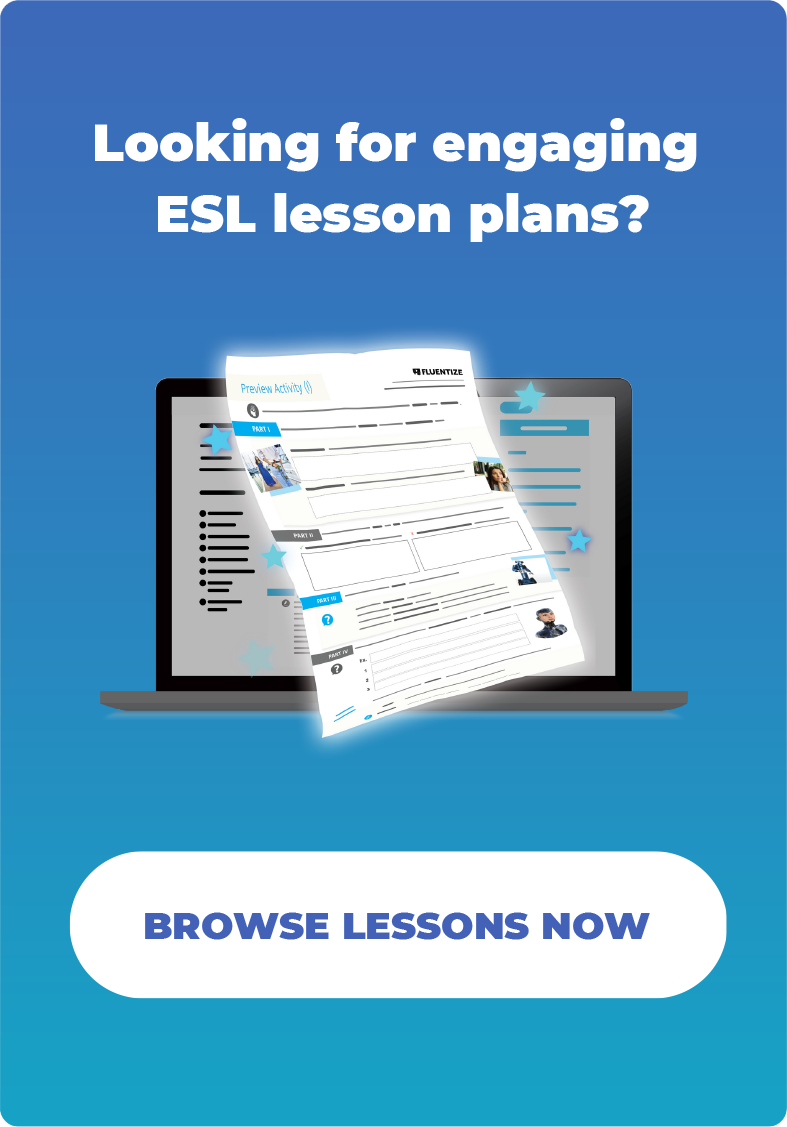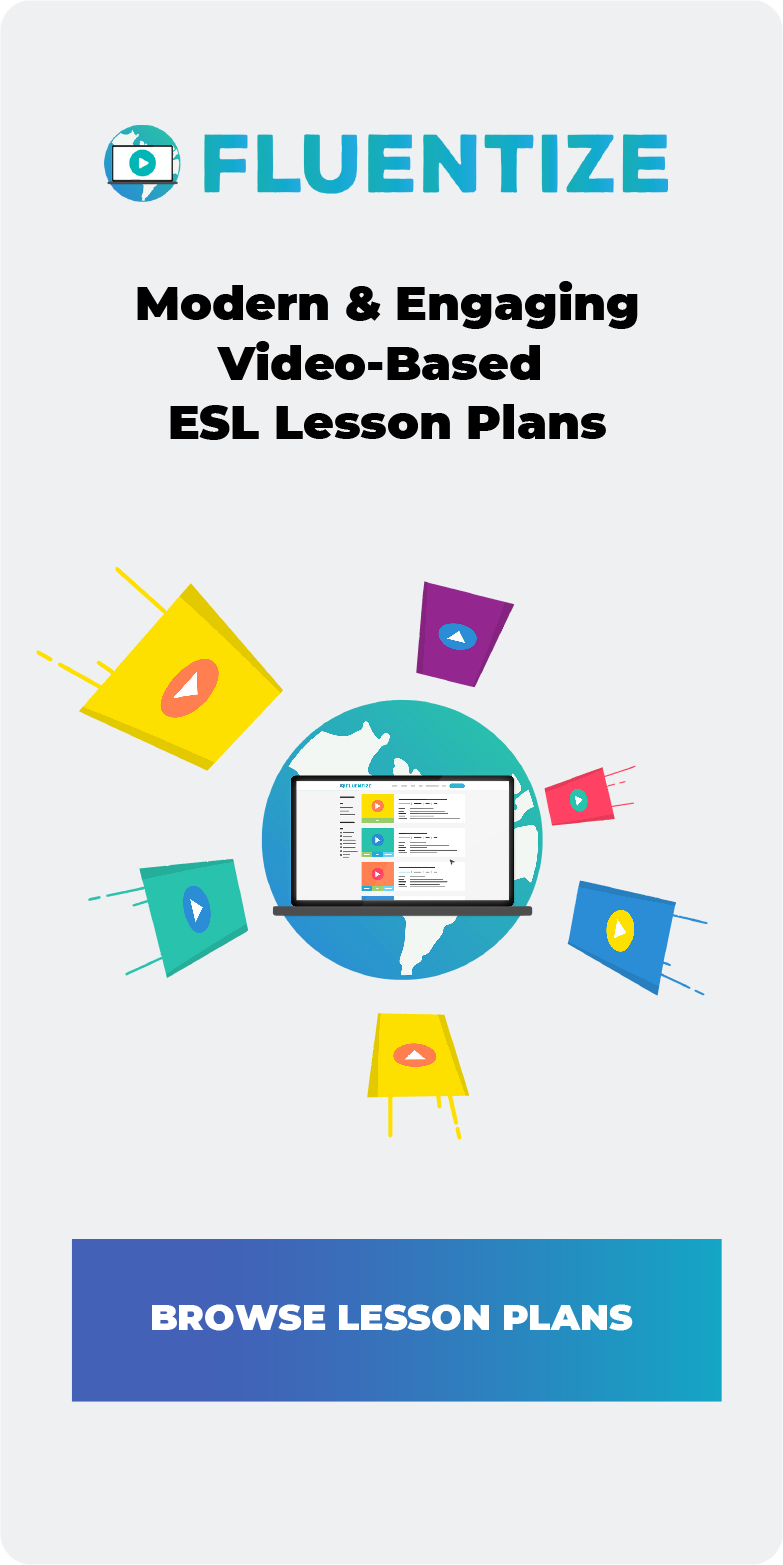Every teacher and student can benefit from fun ESL speaking activities. Some students might be shy to speak, and others may have a hard time with it. And for teachers, coming up with ideas to get students speaking can be tough.
Luckily, the 12 fun ESL speaking activities in this post are easy to prepare and great for boosting students’ confidence. We’ll cover everything from the types of tasks and procedures to use during an activity, to planning an effective speaking lesson. Plus, we’ll share tips on giving feedback to help improve your students’ speaking skills.
12 fun ESL speaking activities for adults & teens
Let’s look at 12 fun ESL speaking activities for your classroom. These are fun ESL activities for both adults and teens, and can be easily implemented in both one-to-one lessons or group lessons. You can also do them in online lessons or in a physical classroom! We’ve also got bonus tips to help you improve or expand upon each ESL speaking activity.
1. Guess the Story
🎯 Speaking Objective: Build storytelling skills.
📊 Suitable Levels: All levels
📋 Procedure:
- Show students several pictures on a screen. These pictures tell a story.
- Ask students to guess, make up, and/or build the story from what they see.
- You can help them by giving hints or asking questions about the pictures.
✍️ Feedback Focus: Check how they connect ideas and use the past tense.
Here is an example concept from a lesson plan on Fluentize:

As mentioned, make sure you get students to build upon the story. You can create and ask follow-up questions based on the theme of the images. For example, for the image set above, you could ask students:
- What do you think the couple and dog will do together on their first day?
- Have you ever adopted a pet? If so, was it an easy or hard process? If not, do you think it would be easy or hard to do?
- Do you own a pet? If so, what do you like to do with your pet? If not, would you like to have a pet? Why or why not?
✅ BONUS TIP: Sometimes searching for and finding the right photos can take a bit of time. To save time, you could simply show students a few of your own, personal photos. They could be from a holiday celebration, an event you attended, a trip you took, etc. Tell your story about them. This can add a special personal touch to the activity. Then, you could ask students to choose a few photos from their own photo library to describe or tell a story about.
If you’re looking for a similar style and topic for a lesson, check out this effective lesson plan about describing a photo written by Silvina, one of Fluentize’s team members.
2. A-D-C Activities
🎯 Speaking Objective: Practice sharing and discussing opinions.
📊 Suitable Levels: A2 and above
📋 Procedure:
- Write a statement on the board, such as “Kids shouldn’t have smartphones.”
- Students choose to agree (A), disagree (D), or change the statement (C).
- If you’re in a group class, students can go around or ask around the class to find classmates who have different views. They discuss their opinions with each other.
- If the lesson is one-to-one, you and your student can simply take turns sharing your opinions together.
✍️ Feedback Focus: Focus on how well they explain their opinions and use language appropriately.
✅ BONUS TIP: Have a couple more statements ready for discussion on a similar theme. For example, you could have:
- Schools should confiscate students’ smartphones during school hours.
- Smartphones make us smarter.

Just a few speaking topics like these can really generate engaging and rich discussion for extended periods of time. The great part is that you can adapt and adjust them according to the theme you want to cover. And they’re usually pretty quick and easy to create, and you really only need a few.
3. Simple Picture Guessing Game
🎯 Speaking Objective: Improve question and answer skills.
📊 Suitable Levels: A2 – B1
📋 Procedure:
- Pair up students, or work with your student.
- Give one student a picture but don’t let them show it to their partner.
- The other student asks questions to guess what’s in the picture.
✍️ Feedback Focus: Observe and note how they ask questions and describe things.

✅ BONUS TIP: Before doing this activity, especially for lower levels, do a review of question formation. Focus mostly on yes/no questions in the present simple/continuous, using both the verb “to be” and “do / does”. This skill definitely will come in handy in the activity. You can go through structures such as:
- Is there [noun]? / Are there [noun]…?
- Do / Does [object] + [verb]…?
- Is [object] + [verb-ing]…? / Are [object(s)] + [verb-ing]…?
4. Running Dictation
🎯 Speaking Objective: Boost speaking fluency and listening skills.
📊 Suitable Levels: A2 and above
📋 Procedure:
- If you teach in-person classes, place text on walls around the room. If you teach online, use online flashcards.
- Students work in pairs. One student runs to read the text and remembers parts of it.
- They run back and tell their partner what they remember. They switch roles until they have the whole text.
✍️ Feedback focus: Watch their pronunciation and how they remember and understand the text.
5. Interview Pop

🎯 Speaking Objective: Develop on-the-spot speaking, train question formation, and creativity skills.
📊 Suitable Levels: B1 and above
📋 Procedure:
- Put students in pairs, or you could also take a role in a one-one lesson.
- Students choose one person they want to interview. It can be anybody of their choice, and the person doesn’t necessarily have to be alive still. I tell students to choose someone they know a lot about or who they admire because then they’ll have more material to talk about when the speaking part of the activity comes around.
- Give each student a list of 10 – 15 verbs. (Can be the same list or different). You can cut these up, write these on a piece of paper, or put them on the whiteboard. See the examples:

- Each student has to choose 5 verbs from their list. They make a different question using one of their five verbs in each question; these questions are made for the person they want to interview. Each question will have a different verb.
For example, let’s say a student chooses Barack Obama. They have to make five interview questions for Barack Obama, each question using a different verb from their list.
Here are some examples:
- How did you decide you want to become president?
- Did you want to continue being president after your term finished?
- What did you love about being the president?
- What would you change about the USA?
- What do you consider to be your greatest accomplishment as president?
While you can come up with the verbs myself, you can also find some verb lists online, along with a list of people for your students to choose from.
- While the students are making their questions, go through the class and help students fix the grammatical mistakes in their questions. If you’re doing a one-one lesson, just go through the errors after the student has finished writing their questions.
- The student(s) then give their partner the questions (or gives you the questions) that they wrote and then the student assumes the role of the person they wanted to interview, while their partner asks them the questions they just made.
- So this means that each student answers the questions from the perspective of the person they wanted to interview, as their partner asks them the questions.
Go around to listen for and record mistakes if you’re teaching a group class.
✅ BONUS TIP: Have students report to the class the person their partner chose and how they responded to the questions.
✍️ Feedback Focus: Observe and take note of the grammatical errors they make, either in their questions or in their conversations. You can then focus on these mistakes after the activity or in the next lesson.
Have fun!
6. Empathetic Role Play
🎯 Speaking Objective: Students practice talking kindly. They act out tough situations and learn to respond with support.
📊 Suitable Level: C1
📋 Procedure:
Divide the students into pairs (Student A and Student B). Here are the role cards:
Student A:
- Ask Student B how they are.
- Respond to the tough situation/experience they’re going through.
- In your conversation, do some or all of the following:
- Lend an ear and offer support
- Validate their feelings
- Try to be constructive and insightful
Student B:
- Tell Student A how you are.
- Describe a tough situation/experience you’re going through.
- In your conversation, do some or all of the following:
- Voice your discontent and your emotions
- Vent about the situation and its impact on you
- Ask for support
- Express gratitude
✍️ Feedback Focus: Remind students to listen well to their partner. Tell them how they are doing by using kind words.
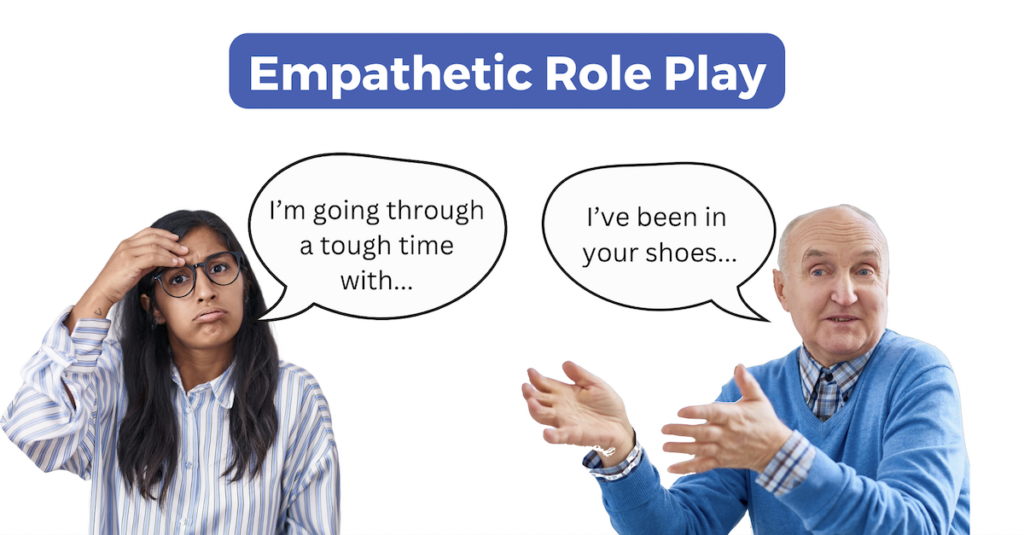
✅ BONUS TIP: When you do role play activities, it’s helpful for students to have some context. This helps students better prepare and conduct the role plays. If you give students a role play activity without any context, they may be a bit lost or disoriented. That’s why it’s usually more effective to save role play activities for the end of the lesson, after you’ve covered a particular theme.
Check out the empathetic role play activity described above in full from our C1 Fluentize lesson: Breaking Down Toxic Positivity.
In that lesson plan, students learn about the topic of toxic positivity and how to express genuine empathy to others. At the end, there is a role play. They practice showing empathy and support, and help each other work through challenging life situations.
These kinds of supportive but fun ESL speaking activities help students improve their listening and speaking skills. Additionally, students can safely share their feelings and accept support. It also helps them become better at understanding others’ emotions.
7. Story…in a Bag!
🎯 Speaking Objective: Create and share stories.
📊 Suitable Levels: B1 and above
📋 Procedure:
- Before class, prepare several bags with 5-6 random objects in each.
- Try to mix common and unusual items.
- For example, put in a postcard, a can opener, a candle, a face mask, a movie ticket, and a teddy bear.
- Divide your students into groups and give each one a bag.
- They open the bags and look at the objects.
- They talk and come up with ideas and make up a story using the items.
✍️ Feedback Focus: Listen for clear storytelling and correct use of vocabulary.

The story should be told aloud, not written down. This approach lets everyone in the group participate. They can add their own ideas to the story. They can also make changes as they go along.
The groups finish creating their stories. Each group shares their story with the whole class. As they tell their story, they should show each object when it comes up in the narrative.
You can demo your own story for students as well. For example:
“Sonia receives a postcard from her best friend in Brazil. Her friend invites Sonia to visit. On her first night in Brazil, they go to a movie. After the movie, they return home and try to turn on the lights, but there’s no power. So, Sonia uses the candle from her bag to light up the room.”
For online lessons, you can use Google Slides. You can upload pictures of different objects into each slide. Assign each group a slide with objects. Let them create a story using the items in the pictures. They can then share their stories and slides with the class in a virtual session.
✅ BONUS TIP: Give students some prompts to work with to practice specific tenses or time expressions. For example, to position students to practice the past simple tense, you can give them prompts such as:
- Last night, …
- Yesterday, …
- One week ago, …
- When…
Then, students should use these prompts in their stories. You could even apply this idea to other tenses, linking words, conjunctions, etc. See the examples:
- After…
- So, …
- However, …
- Even though…
Alternatively, you could make the target skill focused on making plans (as opposed to telling a story).
As you can see, this is an adaptable activity that works well in various contexts.
8. Foodie Talk
🎯 Speaking Objective: Use food vocabulary in conversation.
📊 Suitable Levels: A1/A2
📋 Procedure:
The day before the class, assign students a simple homework task: They take a picture of the inside of their fridges. This picture will serve as the basis for the next day’s classroom discussion.
Then, in class:
- Pair up students, or work with your student if the class is one-to-one.
- Students ask each other questions about what is in their fridges.
- They start by asking simple questions. For example, “Do you have any milk?”

✍️ Feedback Focus: React to students’ language when they need help. Listen to them speak and offer help right at that moment. Correct mistakes or explain words as they use them. This helps students learn better because they understand their errors immediately.
✅ BONUS TIP: You can help students extend conversations in several ways. For example, you could instruct students to:
- Ask more questions about food likes and discuss their preferences.
- Come up with meals together, which they could make using the ingredients they each have.
- Make a shopping list of things they want to buy this week to fill their fridge.
This can be a very effective activity for practicing determiners and articles, such as:
- any / some (Do you have any milk? Yes, I have some milk.)
- an / a (I have an orange.)
Here are some other benefits of this speaking activity:
Dogme approach
This activity uses the Dogme approach. It uses real things students know. Students talk about what is in their fridges. They use their own words. This helps them learn new vocabulary and grammar in practice.
Emergent language
Students learn new vocabulary and how to ask questions. A student may ask, “Do you have mangoes?” Another might answer, “No, I don’t have any mangoes.” They learn by using new vocabulary in speaking.
Clarifying language structures
Students sometimes need help with phrases. They might not know how to ask, “Do you have…?” You can help them. Teach them to say, “Yes, I do” or “No, I don’t.” This makes them more sure when they speak.
Cultural sensitivity
Talk about different foods and customs. If a student doesn’t know what beer is, explain it. Talk about why some people might not drink it. This helps everyone learn about different cultures.
Intentional error correction
Do not correct every mistake. Let students talk freely. Focus on letting them speak more than on perfect grammar. Give feedback later. This helps them feel more comfortable talking.
This activity helps even beginners have real conversations. They use what they know about their lives. This helps them learn better and feel more confident.
9. True/False Stories
This one is inspired by British TV Show “Would I Lie to You?”
🎯 Speaking objective: Practice telling and questioning about stories.
📊 Suitable levels: B1 and above
📋 Procedure: “Would I Lie to You?” is a game where you need at least 4 players, but more can join. You can also easily adapt it to work for one-to-one lessons. The goal is to figure out if the story someone tells is true or false. Here’s how you play with students:
- Divide the class into two teams.
- Players take turns standing up and sharing a story about themselves.
- The story can be funny, weird, or surprising. After the story, the opposing team listens carefully.
- They ask questions to help them decide if the storyteller is lying.
- Then, the team votes on whether they think the whole story was true, only part of it was true, or completely made up.
- The storyteller reveals if they were lying or telling the truth.

Teams score points based on their correct guesses. If the guessing team is right, they get a point. If they’re wrong, the storytelling team scores.
For one-to-one lessons, the student tells a story with both true and false parts. You ask questions to determine its authenticity, then guess if it’s true or false. After revealing the answer, you can switch roles, allowing the student to ask questions while you tell a story. Focus on how convincing the stories are and the effectiveness of the student’s questions.
✍️ Feedback focus: Look at how students make their stories believable and how they ask questions.
This is featured as one of our fun ESL speaking activities because it gets everyone to talk and listen. It’s about how you tell your story and the questions you ask. You also need to think fast to answer questions or figure out if someone is lying. The best part is the surprises. Some true stories are so strange they’re hard to believe. Some lies sound like they could be true. It’s always exciting to see what happens next!
10. Perfect Match (Dating Game!)

🎯 Speaking objective: Describe people and their personalities.
📊 Suitable levels: A2 and above
📋 Procedure:
- Show a picture of a person on the board.
- Ask students to imagine this person’s name, age, job, and hobbies.
- Write their ideas on the board.
- Have students describe what kind of person this character would like to meet.
- Students each get a different picture of a person.
- They write a profile for their person and who they would like to meet.
- They go around the classroom, talking to others to find a good match for their character.
If the lesson is one-to-one, you could follow these steps:
- Provide the student with a set of pictures of different people, each with a short bio.
- Your student selects a picture and expands on the details (personality, hobbies, etc.).
- Your student describes the ideal match for that character.
- You can present additional pictures with bios of potential matches.
- Student reviews the options and selects a match.
Encourage your student to explain why the chosen match would be compatible. For instance, they describe each person’s personality traits and interests. Then, you can provide feedback on the student’s use of adjectives and reasoning.
✍️ Feedback focus: Focus on their use of adjectives and phrases for describing people. Observe and note how they interact with others.
✅ BONUS TIP: Play some romantic music to make it fun.
At the end, discuss as a class if the matches would work.
11. Two Truths and A Lie — Twisted
From this full list of fun ESL speaking activities, this is one of our top favorites!
🎯 Speaking Objective: Practice identifying truths and lies.
📊 Suitable Levels: B1 and above
📋 Procedure:
Write 5 statements about yourself on the board. Each sentence fits into a category:
- “Thank God it’s a lie!”
- “Sad but true!”
- “Wish it were true!”
- “Hard to admit!”
- “True and awesome!”
Students guess which sentences match each category. Then, they make their own statements that fit into each of the same categories. They talk to their classmates about their guesses and explain why they think so. If your lesson is one-to-one, you can participate in the activity and guess which ones fit in the categories.
✍️ Feedback Focus: Observe how students explain their reasoning, and how they use phrases to express opinions.
✅ BONUS TIP: Have students ask some follow-up questions, or ask them follow-up questions, based on their statements. This will generate engaging discussion. Here are some examples:
Statement: “I once ate dinner with a celebrity.” (True and awesome)
Follow-up Question:“How did you feel when you met the celebrity, and what did you talk about?”
Statement: “I enjoy singing along to cheesy pop songs in the car.” (Hard to admit)
Follow-up Question: “What are your go-to cheesy pop songs or bands for singing along?”
12. What’s Your Top 5…?
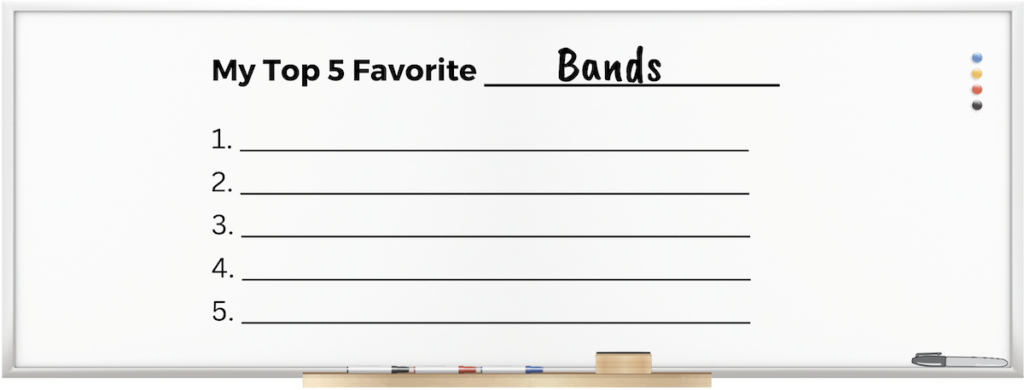
🎯 Speaking Objective: Use language to rank and justify choices.
📊 Suitable Levels: A2 and above
📋 Procedure:
- Students create lists of their top 5 favorite things across different categories like TV shows, songs, or foods.
- They present their lists and explain why they chose these items.
✍️ Feedback Focus: Listen for their ability to explain and defend their choices clearly.
As you’ll see, this is a very simple and straightforward activity to set up. It’s effective because it’s relatable and students generally have a lot to say about their favorites.
✅ BONUS TIP: Have students choose a category or two they want to create their lists for. For example, you could have them choose:
- Top 5 favorite sports teams
- Top 5 favorite apps or websites
- Top 5 favotite role models or inspirational people
- Top 5 travel destinations
- Top 5 favorite restaurants, cafes, or bars
When they make their lists, instruct them to ask follow-up questions and/or compare their lists. This will drive further discussion.
These fun ESL speaking activities are great, aren’t they? They will make learning engaging. Also, they will help students build confidence in using English in various contexts.
Lesson stages for fun ESL speaking activities
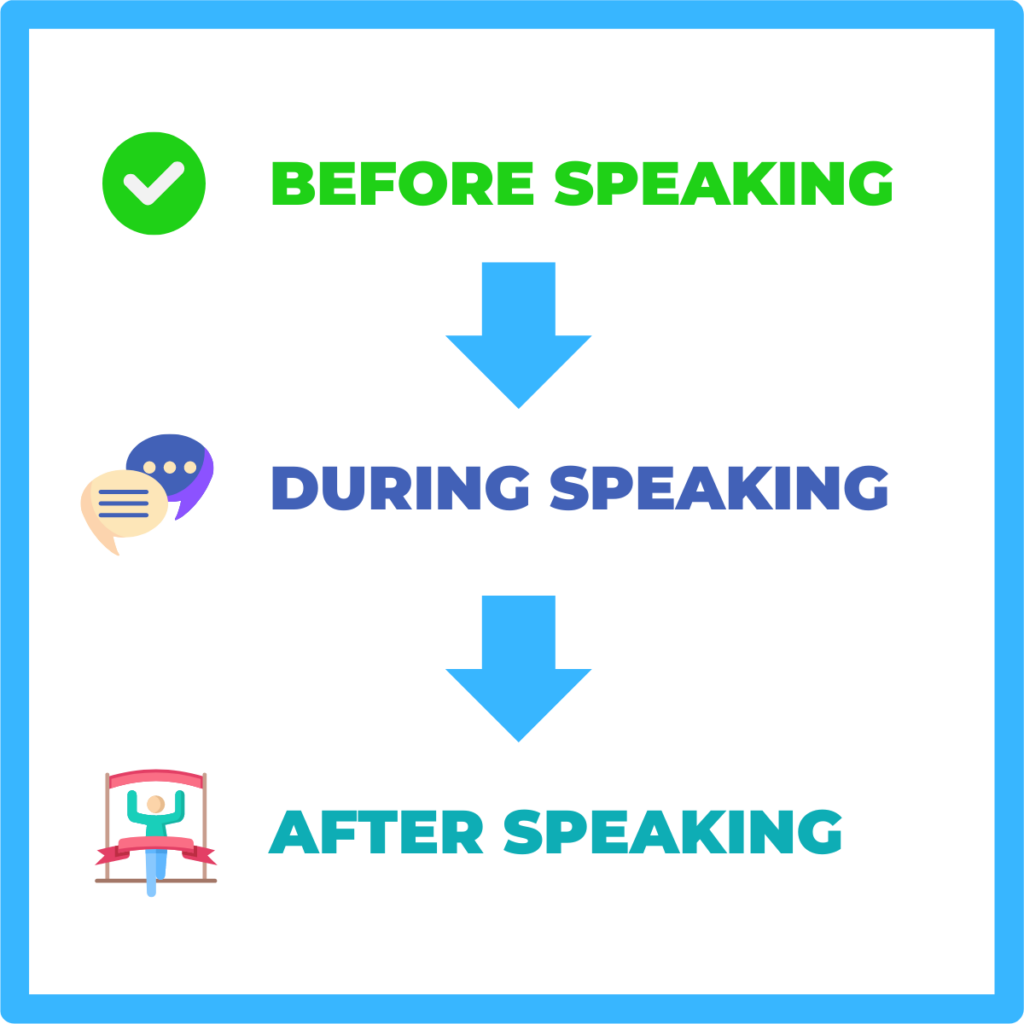
After exploring these 12 fun ESL speaking activities, it’s important to understand how to structure these activities in your lessons. Now, here we’ll outline the stages of a communicative skills lesson. These steps help organize the lesson from start to finish. They will make sure that the speaking activities are effective and engaging for all students. Wouldn’t you want your students to benefit as much as possible?
Follow these steps to ensure your students get the most out of the speaking activities.
A. Before speaking skill stage
- Start by introducing the broader topic of the lesson. This sets the stage for everything that follows.
- Introduce essential language.
- Pick 1-4 important words or phrases that students need to know. They should understand these and use them often during the activity.
- For each word or phrase, use the steps: elicit the word from the students, practice it, check if they understand (with concept-checking questions), and write it on the board.
- Adjust or clarify the context if needed. This helps smoothly transition into the main activity.
B. During speaking skill stage
6. Break the activity into smaller parts. It’s less scary for learners to handle 3-5 minute sections than one long 15-minute task. This approach also simplifies instructions and lets you gradually increase the task’s difficulty.
- Explain/Instruct what to do.
- Use simple and concise language to describe the task.
- Demonstrate or show them how to do it, either by doing it yourself or with a student’s help.
- Ask questions to check understanding if you think it’s necessary.
- Group the students appropriately and give them the materials they need.
- Watch and listen as the students work.
- Stay out of the way.
- Write down any language problems, errors, etc. you notice or hear.
- Only step in if they really need help, like if they don’t understand the instructions or can’t communicate at all.
C. After speaking skill stage
7. Let students give feedback to each other.
- They can share and compare their answers or ideas.
- Discuss as a whole class.
- This wraps up the task. You might ask what they found out or learned about the topic or their classmates.
- Correct important mistakes.
- Focus on significant errors, especially those related to the language or topic you’ve just taught, or ongoing issues.
- End the lesson.
- Sum up what they’ve learned. Ask them to recall key phrases or discuss what they did during the lesson. Reflect on what they can do now that they couldn’t do before.
These stages will guide you through a speaking lesson. They will make your students feel supported and clear about what they’re learning. Remember, the key is to make speaking less daunting and more manageable.
Transitioning from fun ESL speaking activities to practical tips
We looked at 12 fun ESL speaking activities for adults and teens, and the main stages of a speaking lesson. Now, let’s look at 11 simple tips. These tips will help your students speak better and feel more confident.
- Let students role-play real situations to help them speak better. This teaches them how to use language in practical contexts.
- Make the classroom safe for speaking so students feel comfortable. They will be more likely to participate if they aren’t afraid of making mistakes.
- Pair students to learn from each other and boost confidence. They can often understand and support each other in unique ways.
- Teach language that students will actually use outside class. Practical language skills are directly applicable and motivating.
- Let students talk more and teach less during class time. More speaking practice improves their language skills faster.
- Use topics in class that interest your students to keep them engaged. Interested students are more attentive and willing to participate.
- Show students how learning from classmates can be useful. Peer examples provide relatable models of language use.
- Encourage students to talk about their own experiences. This personalizes learning and makes it more relevant to them.
- Give feedback that helps students improve their speaking. Constructive feedback guides their learning and development.
- Create tasks that make students use English in a fun way. Enjoyable activities increase motivation and retention of language skills.
- Have an adaptable mindset. You can adapt any of these activities according to your lesson objectives and students’ skill level. Try to build upon each of the activities.
Understanding of core speaking skills in fun ESL activities

So, as you probably know, teaching speaking isn’t just about letting students talk. It’s about guiding them to use English effectively and confidently. If you’re using fun ESL speaking activities, here are the key speaking skills to focus on
- Pronunciation: This goes beyond just the correct articulation of vowels and consonants. It includes teaching students how to stress words in sentences to convey meaning. They use intonation patterns to differentiate between new and known information.
- Speech functions: Equip students with the skills to perform various “speech acts”. A speech act is how we use language to do something in conversation, like making a request, offering help, or expressing an opinion.
- Requesting: They learn to ask for things politely, like help or permission.
- Expressing: Students practice showing feelings such as gratitude, approval, or disappointment.
- Explaining: They gain the ability to clarify complex ideas or instructions clearly and logically.
- Directing: This includes giving commands or guiding others through instructions.
- Offering: Teach students how to provide suggestions or condolences in a thoughtful way.
- Describing: This skill helps students paint vivid pictures of their experiences or surroundings through words.
- Interaction management: This skill set is crucial for conversational fluency and includes:
- Initiating conversations: Starting talks without hesitation.
- Maintaining flow: Keeping conversations going smoothly and naturally.
- Ending conversations: Learning how to close discussions politely and appropriately.
- Managing turns: Sharing speaking time and navigating exchanges in group settings.
- Discourse organization: Students learn to structure their spoken contributions effectively:
- Cohesion and coherence: Making their speech logical and connected, using linguistic tools to link ideas.
- Using discourse markers: These are words or phrases like “however,” “firstly,” or “on the other hand,” which guide listeners through the shifts and continuities in speech.
Adapted from: Goh & Burns (2012: 59)
Understanding and teaching these sub-skills in your ESL classroom can transform simple speaking tasks into rich, communicative experiences. These foundations improve the effectiveness of fun ESL activities. They also empower students to handle many speaking environments confidently.
Improving fun ESL speaking activities with better task design
Let’s explore how to make your ESL speaking tasks more effective. We’ll look at what makes a task good and the different types of tasks you can use.
Criteria for effective speaking tasks
| Characteristic | Description |
| Authentic | Does the activity resemble real-life situations? |
| Specific outcome | Does the activity have a clear objective? |
| Encouraging | Does the activity encourage spoken language production? |
| Challenging | Does the activity offer a suitable level of difficulty? |
| Interactive | Does the activity involve both speakers and listeners? |
| Spontaneous & unpredictable | Does the activity include communication problems or unexpected events? |
| Flexible | Is the activity easy to set up and repeat? |
Types of speaking activities
- Describing: Describing photos, videos, or other kinds of media or content.
- Debating: Agreeing / Disagreeing with certain statements or ideas
- Listing: Brainstorming or fact-finding, like making a list of places in a city and their functions.
- Ordering & sorting: Sequencing events or ranking items, such as ranking technology tools by usefulness. Then, explaining the order.
- Comparing: Finding, describing, or analyzing similarities / differences in texts, pictures, or even concepts.
- Problem solving: Solving puzzles or real-life problems, like deciding on traffic reduction solutions
- Sharing personal experiences: Sharing experiences or reminiscences, discussing attitudes, opinions, or preferences, and reacting to classmates’ experiences.
- Presenting: Presenting ideas and information in formal or informal contexts.
- Planning: Making plans with another person, such as planning a party with a limited budget
- Creating: Conducting experiments, investigating social or historical topics, creating media projects
- Role playing: Acting out real-life scenarios, like job interviews.
If you’re looking for ESL lesson plans that include these types of speaking activities mentioned above, come give the Fluentize lesson plans a try. Each of our video-based lesson plans has a focus on speaking skills. They include various types of these activities.
Concluding Thoughts on Fun ESL Speaking Activities for Adults & Teens
To wrap up, these fun ESL speaking activities are an effective way to add spark to your lessons. They’re simple to set up, easy for students to get into, and they boost confidence like nobody’s business. So, what are you waiting for? Time to dive in and make your speaking classes a blast for your ESL students!


